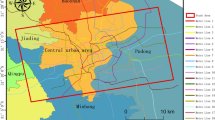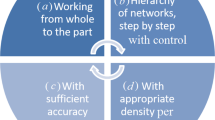Abstract
Persistent scatterer interferometric synthetic aperture radar (PS-InSAR) is a widely used technique for local ground deformation estimation due to its millimetric accuracy and full-resolution results. However, with the enhancement of data acquisition capability of the SAR sensors, larger coverage and higher temporal-spatial resolution of SAR images can cause explosive increase and uneven distribution of PS points. PS network constructed between PSs with different qualities may cause spatial-error propagation. Large PS points list with large amount of data also have high requirements on computing performance and storage space. Those problems can bring big challenge for PS-InSAR technique in processing capacity, deformation monitoring accuracy and algorithm efficiency. In order to effectively overcome those limitations, this paper proposed a novel block PS-InSAR method that uses the approach of partitioning a study area into regular blocks with overlapping regions, selecting a high-quality reference point for each block and eliminating the discontinuity of the parameter calculating results in adjacent blocks by the weighted least square method. We used this approach to analyze ground subsidence in over 13,000 km2 of southern California, and it performed successfully when 69 Sentinel-1 images were used and 21,029,968 PSs were selected. Only approximately 10 h was needed for this experiment. Comparing the deformation rate and time series of the InSAR results with 29 GPS observations, the mean and standard deviation of difference of deformation rate were − 0.63 mm/yr and 1.53 mm/yr, respectively, and the average root mean squared error of deformation time series was 3.7 mm. The experiment demonstrated that this method could achieve high accuracy results without spatial discontinuity and increase the computational efficiency significantly.








Similar content being viewed by others
Data availability
The Sentinel-1 datasets analyzed during the current study are available from https://search.asf.alaska.edu/, and the GNSS datasets are available from Southern California Integrated GPS Network (SCIGN, http://www.scign.org).
References
Colesanti C, Ferretti A, Novali F, Prati C, Rocca F (2003a) Sar monitoring of progressive and seasonal ground deformation using the permanent scatterers technique. IEEE Trans Geosci Remote Sens 41:1685–1701. https://doi.org/10.1109/tgrs.2003.813278
Colesanti C, Ferretti A, Prati C, Rocca F (2003b) Monitoring landslides and tectonic motions with the permanent scatterers technique. Eng Geol 68:3–14
Crosetto M, Monserrat O, Cuevas-González M, Devanthéry N, Crippa B (2016) Persistent scatterer interferometry: a review. ISPRS J Photogramm Remote Sens 115:78–89. https://doi.org/10.1016/j.isprsjprs.2015.10.011
Dai Y, Dai WJ (2020) An adaptive robust kalman filtering method with observation quality information. Eng Surv Mapp 29:67–70
Esene C, Rezaei N, Aborig A, Zendehboudi S (2019) Comprehensive review of carbonated water injection for enhanced oil recovery. Fuel 237:1086–1107. https://doi.org/10.1016/j.fuel.2018.08.106
Ferretti A, Prati C, Rocca F (2000) Nonlinear subsidence rate estimation using permanent scatterers in differential SAR interferometry. IEEE Trans Geosci Remote Sens 38:2202–2212
Ferretti A, Prati C, Rocca F (2001) Permanent scatterers in SAR interferometry. IEEE Trans Geosci Remote Sens 39:8–20
Ge DQ, Wang Y, Zhang L, Xia Y, Wang Y, Guo XF (2009) Using permanent scatterer InSAR to monitor land subsidence along High Speed Railway-the first experiment in China. In: Fringe, Frascati, Italy
Goel K, Adam N (2014) A distributed scatterer interferometry approach for precision monitoring of known surface deformation Phenomena. IEEE Trans Geosci Remote Sens 52:5454–5468. https://doi.org/10.1109/tgrs.2013.2289370
Hanssen R (2001) Radar interferometry: data interpretation and error analysis. Springer, Berlin
Hanssen R, Caro Cuenca M, Hooper A, Mahapatra P, Arikan M, Bekaert D (2012) New trends in InSAR time series analysis for wide area deformation mapping. In: EGU general assembly conference abstracts, pp 13821
Hooper A (2008) A multi-temporal InSAR method incorporating both persistent scatterer and small baseline approaches. Geophys Res Lett. https://doi.org/10.1029/2008gl034654
Hooper A, Zebker HA (2007) Phase unwrapping in three dimensions with application to InSAR time series. J Opt Soc Am A Opt Image Sci vis 24:2737–2747. https://doi.org/10.1364/josaa.24.002737
Hooper A, Zebker HA, Segall P, Kampes B (2004) A new method for measuring deformation on volcanoes and other natural terrains using InSAR persistent scatterers. Geophys Res Lett. https://doi.org/10.1029/2004gl021737
Hu B, Chen X, Zhang X (2019) Using multisensor SAR datasets to monitor land subsidence in Los Angeles from 2003 to 2017. J Sensors 2019:1–15. https://doi.org/10.1155/2019/9389820
Hu J, Ding XL, Li ZW, Zhang L, Zhu J, Sun Q, Gao G (2016) Vertical and horizontal displacements of Los Angeles from InSAR and GPS time series analysis: resolving tectonic and anthropogenic motions. J Geodyn 99:27–38. https://doi.org/10.1016/j.jog.2016.05.003
Hu J, Li Z, Ding X, Zhu J, Sun Q (2013) Spatial–temporal surface deformation of Los Angeles over 2003–2007 from weighted least squares DInSAR. Int J Appl Earth Obs Geoinf 21:484–492. https://doi.org/10.1016/j.jag.2012.07.007
Kahmen H, Faig W (2012) Surveying. Walter de Gruyter
Kampes BM (2006) Radar interferometry: persistent scatterer technique. Springer, Berlin
Lanari R, Lundgren P, Manzo M, Casu F (2004) Satellite radar interferometry time series analysis of surface deformation for Los Angeles. Geophys Res Lett, California. https://doi.org/10.1029/2004gl021294
Leijen V (2014) Persistent Scatterer Interferometry based on geodetic estimation theory. Delft University of Technology, TU Delft
Li T, Liu G, Lin H, Jia H, Zhang R, Yu B, Luo Q (2014) A hierarchical multi-temporal InSAR method for increasing the spatial density of deformation measurements. Remote Sens 6:3349–3368. https://doi.org/10.3390/rs6043349
Li Z, Cao Y, Wei J, Duan M, Wu L, Hou J, Zhu J (2019) Time-series InSAR ground deformation monitoring: Atmospheric delay modeling and estimating. Earth Sci Rev 192:258–284. https://doi.org/10.1016/j.earscirev.2019.03.008
Liu S (2012) Satellite radar interferometry: estimation of atmospheric delay. NCG, Nederlands Commissie voor Geodesie, Netherlands Geodetic Commission
Lu Z, Danskin WR (2001) InSAR analysis of natural recharge to define structure of a ground-water basin, San Bernardino, California. Geophys Res Lett 28:2661–2664. https://doi.org/10.1029/2000gl012753
Neely WR, Borsa AA, Silverii F (2020) GInSAR: a cGPS correction for enhanced InSAR time series. IEEE Trans Geosci Remote Sens 58:136–146. https://doi.org/10.1109/tgrs.2019.2934118
Ng AH-M, Ge L, Li X, Zhang K (2011) Monitoring ground deformation in Beijing, China with persistent scatterer SAR interferometry. J Geodesyst 86:375–392. https://doi.org/10.1007/s00190-011-0525-4
Osmanoğlu B, Dixon TH, Wdowinski S, Cabral-Cano E, Jiang Y (2011) Mexico City subsidence observed with persistent scatterer InSAR. Int J Appl Earth Obs Geoinf 13:1–12. https://doi.org/10.1016/j.jag.2010.05.009
Samsonov S, Tiampo K, Rundle J, Li Z (2007) Application of DInSAR-GPS optimization for derivation of fine-scale surface motion maps of Southern California. IEEE Trans Geosci Remote Sens 45:512–521. https://doi.org/10.1109/tgrs.2006.887166
Shanker P, Zebker H (2007) Persistent scatterer selection using maximum likelihood estimation. Geophys Res Lett. https://doi.org/10.1029/2007gl030806
Simons M, Fialko Y, Rivera L (2002) Coseismic deformation from the 1999 M w 7.1 Hector Mine, California, earthquake as inferred from InSAR and GPS observations. Bull Seismol Soc Am 92:1390–1402
Wang Q, Yu W, Xu B, Wei G (2019) Assessing the use of GACOS products for SBAS-InSAR deformation monitoring: a case in Southern California. Sensors 19:3894
Watson KM, Bock Y, Sandwell DT (2002) Satellite interferometric observations of displacements associated with seasonal groundwater in the Los Angeles basin. J Geophys Res Solid Earth 107:8–15. https://doi.org/10.1029/2001jb000470
Wegmüller U, Werner C, Strozzi T, Wiesmann A (2004) Multi-temporal interferometric point target analysis. In: Analysis of multi-temporal remote sensing images. World Scientific, pp 136–144.
Wei J, Li Z, Hu J, Feng G, Duan M (2018) Anisotropy of atmospheric delay in InSAR and its effect on InSAR atmospheric correction. J Geodesyst 93:241–265. https://doi.org/10.1007/s00190-018-1155-x
Werner C, Wegmuller U, Strozzi T, Wiesmann A (2003) Interferometric point target analysis for deformation mapping. In: IGARSS 2003 2003 IEEE international geoscience and remote sensing symposium proceedings (IEEE Cat No 03CH37477). IEEE, pp. 4362–4364.
Williams S, Bock Y, Fang P (1998) Integrated satellite interferometry: tropospheric noise, GPS estimates and implications for interferometric synthetic aperture radar products. J Geophys Res Solid Earth 103:27051–27067. https://doi.org/10.1029/98jb02794
Xu B, Li Z, Zhu Y, Shi J, Feng G (2020a) Kinematic coregistration of sentinel-1 TOPSAR images based on sequential least squares adjustment. IEEE J Sel Topics Appl Earth Obs Remote Sens 13:3083–3093. https://doi.org/10.1109/jstars.2020.3000043
Xu B, Li Z, Zhu Y, Shi J, Feng G (2020b) SAR interferometric baseline refinement based on flat-earth phase without a ground control point. Remote Sens. https://doi.org/10.3390/rs12020233
Xu W, Li Z, Ding X, Wang C, Feng G (2012) Application of small baseline subsets D-InSAR technology to estimate the time series land deformation and aquifer storage coefficients of Los Angeles area. Chin J Geophys 55:452–461
Xue F, Lv X, Dou F, Yun Y (2020) A review of time-series interferometric SAR techniques: a tutorial for surface deformation analysis. IEEE Geosci Remote Sens Mag 8:22–42. https://doi.org/10.1109/mgrs.2019.2956165
Zhang R, Liu G, Li Z, Zhang G, Lin H, Yu B, Wang X (2014) A hierarchical approach to persistent scatterer network construction and deformation time series estimation. Remote Sensing 7:211–228. https://doi.org/10.3390/rs70100211
Acknowledgements
This work was partly supported by the National Key R&D Program of China, Grant Number 2018YFC1503603; the National Science Fund for Distinguished Young Scholars, Grant Number 41925016; the National Natural Science Foundation of China, Grant Number 41804008; and the Fundamental Research Founds for the Central Universities of Central South University, Grant Number 2019zzts296. We would like to thank ESA (European Space Agency) for supplying the Sentinel-1 datasets. The GPS data used were from the SCIGN website. We thank the anonymous reviewers for their valuable comments, which have helped to improve the quality of this paper.
Author information
Authors and Affiliations
Contributions
B.X. and Z.L. proposed the conception; J.H., B.X. and Z.L. conceived the framework of this research; J.H. and B.X. designed and performed the experiments, analyzed the data in the paper and wrote the paper; Z.L., Y.Z. helped to analyze the data and write the paper; G.F. helped perform the experiments and edit the paper.
Corresponding author
Rights and permissions
About this article
Cite this article
Hou, J., Xu, B., Li, Z. et al. Block PS-InSAR ground deformation estimation for large-scale areas based on network adjustment. J Geod 95, 111 (2021). https://doi.org/10.1007/s00190-021-01561-1
Received:
Accepted:
Published:
DOI: https://doi.org/10.1007/s00190-021-01561-1




